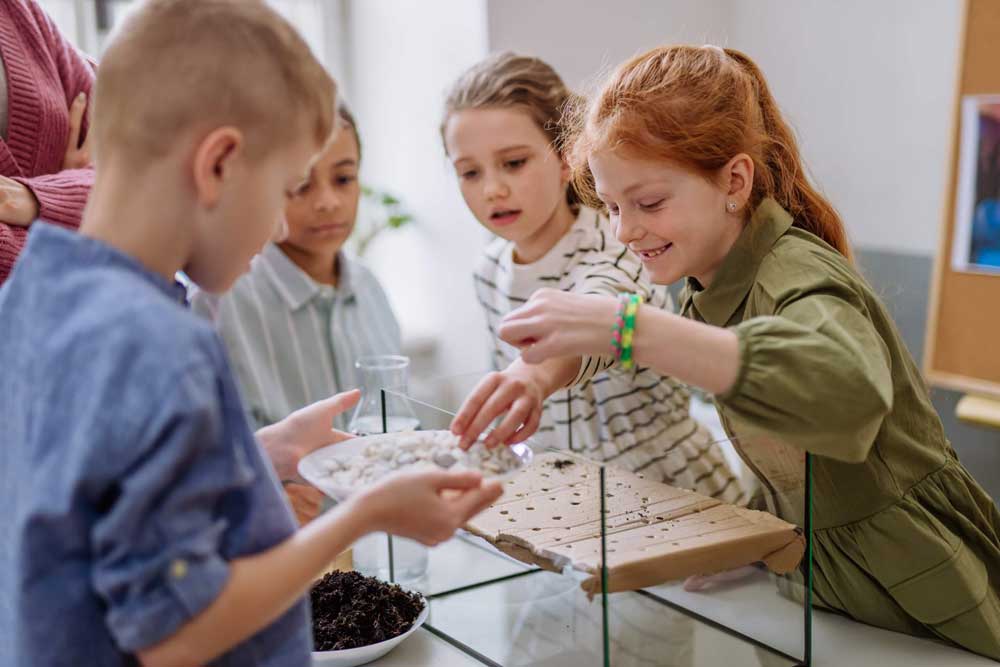Are you looking for fun and educational activities to engage your child’s mind at home?
Look no further! In this article, we will explore the top 10 STEM activities that kids can try out.
STEM (Science, Technology, Engineering, and Mathematics) activities are not only entertaining but also provide valuable learning experiences. By participating in these hands-on experiments and projects, your child can develop problem-solving skills, critical thinking abilities, and a strong foundation in STEM subjects.
Get ready to ignite your child’s curiosity with these exciting activities!
Building a Homemade Volcano
You can build a homemade volcano using materials you have at home, like baking soda and vinegar. It’s an exciting STEM activity that allows your little ones to explore chemical reactions, understand geology, learn about natural disasters, investigate volcanic eruptions, and discover the science behind volcanoes.
To start, gather some household items like a plastic bottle, baking soda, vinegar, dish soap (optional), food coloring (optional), and craft supplies for decorating. Find a safe spot outside or in the kitchen where you can make a mess.
First, decorate the outside of the plastic bottle to resemble a volcano. Let your child’s creativity shine as they design their own unique masterpiece. Once the decorations are complete, place the bottle on a tray or in a shallow container to catch any overflow.
Now it’s time for the eruption! Fill the bottle about halfway with warm water. Add several tablespoons of baking soda and a few drops of dish soap and food coloring if desired. Finally, pour in some vinegar and watch as your volcano comes alive!
As the vinegar reacts with the baking soda, it creates carbon dioxide gas bubbles that cause an eruption. This is similar to how real volcanoes erupt when pressure builds up beneath Earth’s surface.
Through this hands-on activity, kids will not only have fun but also gain valuable knowledge about chemistry and geology. So grab those materials from your kitchen shelves and let your little scientists unleash their inner volcanologists!
Creating Your Own Slime
Get started on creating your own slime at home! Making slime is a fun and interactive activity that will engage little minds while also providing sensory play. Before you begin, it’s important to take some safety precautions. Make sure to supervise kids during the process and keep all ingredients out of reach from young children.
There are different slime recipes you can try, depending on the texture and appearance you want to achieve. For a basic slime, mix together equal parts of glue and liquid starch until it reaches a gooey consistency. You can also experiment with adding food coloring or glitter for some extra pizzazz!
Once you have made your slime, let the sensory play begin! Encourage kids to squish, stretch, and explore the unique texture of their creation. They can even use toys or objects to make imprints in the slime.
To add more excitement, you can create various slime variations by changing up the ingredients. Try using saline solution instead of liquid starch for a stretchier slime, or cornstarch for a more solid-like consistency.
Finally, when it’s time to clean up, store your homemade slime in an airtight container to prevent it from drying out. This way, your little ones can enjoy playing with their slime again and again!
Have fun exploring the world of slimy sensations with these easy-to-follow tips!
Designing and Building a Catapult
After creating your own slime, you can move on to designing and building a catapult. A catapult is a device that uses stored energy to launch objects into the air. It’s a fun STEM activity that will engage your little minds and teach them about physics and engineering.
To start, gather your DIY catapult materials. You’ll need popsicle sticks, rubber bands, a plastic spoon, and small objects like pom-poms or marshmallows for launching. Once you have everything ready, follow these simple steps:
1. Assemble the base of the catapult by attaching two popsicle sticks together in an X shape using rubber bands.
2. Attach another popsicle stick vertically to the center of the X shape.
3. Place the plastic spoon at the end of the vertical stick and secure it with rubber bands.
4. Load your small object onto the spoon.
5. Pull back on the spoon and let go to launch!
Remember to take Catapult safety precautions while playing with your creation. Make sure there is enough space around you and avoid aiming at people or fragile objects.
Experiment with different designs and see how far you can launch your objects! You can try varying the length of the base or changing the angle of release for different results.
Have fun exploring Catapult mechanics as you design, build, and test your very own mini-launcher!
Coding and Programming Games
Coding and programming games allow you to learn about technology while having a blast! It’s an exciting way to engage with STEM and expand your knowledge. Let’s dive into the world of coding and explore algorithm exploration, game design challenges, logic puzzles, Python programming projects, and web development for beginners.
Algorithm exploration is like solving a puzzle. You get to create step-by-step instructions for the computer to follow. As you progress, the challenges become more complex, sharpening your problem-solving skills.
Game design challenges take coding to another level. You can design your own games from scratch! Think about creating characters, setting up levels, and adding special features. The possibilities are endless!
Logic puzzles are brain-teasers that require critical thinking. By deciphering patterns and solving problems, you’ll strengthen your logical reasoning abilities.
Python programming projects offer hands-on experience in one of the most popular coding languages. From building simple programs to developing games or websites, Python opens up a whole new world of possibilities.
Web development for beginners introduces you to HTML, CSS, and JavaScript—the building blocks of the internet! You’ll learn how to create web pages and make them interactive.
By exploring coding and programming games, you’ll gain valuable skills that can set you up for future success in technology-related fields. So grab your computer or tablet and let’s start coding!
Conducting Simple Science Experiments
Explore the world of science by conducting simple experiments at home. It’s a great way to engage your little ones and spark their curiosity about the world around them. Let’s dive into some exciting activities that will not only entertain but also educate your kids.
Begin by exploring chemical reactions. Grab some baking soda and vinegar and watch as they react to create a fizzy explosion. This hands-on experiment will introduce your child to the concept of chemical changes in a fun and interactive way.
Next, investigate the properties of water. Fill different containers with water and let your child observe how it takes on different shapes when poured into various objects. They’ll learn about surface tension, buoyancy, and more.
Now, let’s understand the principles of electricity. Create a simple circuit using batteries, wires, and bulbs. Your child will be fascinated as they see how electricity flows through a closed loop and lights up the bulb.
Moving on, explore the states of matter by freezing water into ice cubes or heating it until it evaporates into steam. This experiment will teach your little one about solids, liquids, and gases.
Lastly, investigate the effects of gravity. Drop various objects from different heights and observe how gravity pulls them towards Earth’s surface. Your child will learn firsthand about this fundamental force that keeps us grounded.
These simple science experiments are just the beginning of an exciting journey into STEM for your kids. Get ready to have fun while learning together!
Frequently Asked Questions
Are there any safety precautions or guidelines to follow when building a homemade volcano?
When building a homemade volcano, safety is key! Remember to take precautions when conducting chemistry experiments. Keep a safe distance, wear protective goggles, and use materials that are non-toxic. Have fun while staying safe!
What are the different types of slime that can be created and how do they differ?
There are various types of slime you can create using different ingredients and recipes. Each type of slime has its own unique texture, allowing for fun and exciting slime experiments! Let’s dive in and explore the world of slime together!
How can I ensure that the catapult I build is safe and won’t cause any harm?
To ensure the safety of your homemade catapult, use soft projectiles and create a designated launch area. Similarly, when making a volcano, avoid using flammable substances and always have adult supervision. Remember to explore slime types, programming languages for games, and simple science experiments too!
What programming languages or software tools can be used to code and program games?
You can use coding languages like Python, Java, and C++ to program games. Game development tools such as Unity and Unreal Engine are popular choices. Software programs like Scratch and GameMaker are great for beginners in programming games. Let’s get started on your game-making journey!
Can you provide some examples of simple science experiments that can be conducted at home?
Sure! Here are some simple science experiments you can try at home:
1) Exploring the properties of water,
2) Fun with magnets,
3) Unleashing the power of air,
4) The wonders of light, and
5) Kitchen chemistry. Let’s dive into the world of science together!




